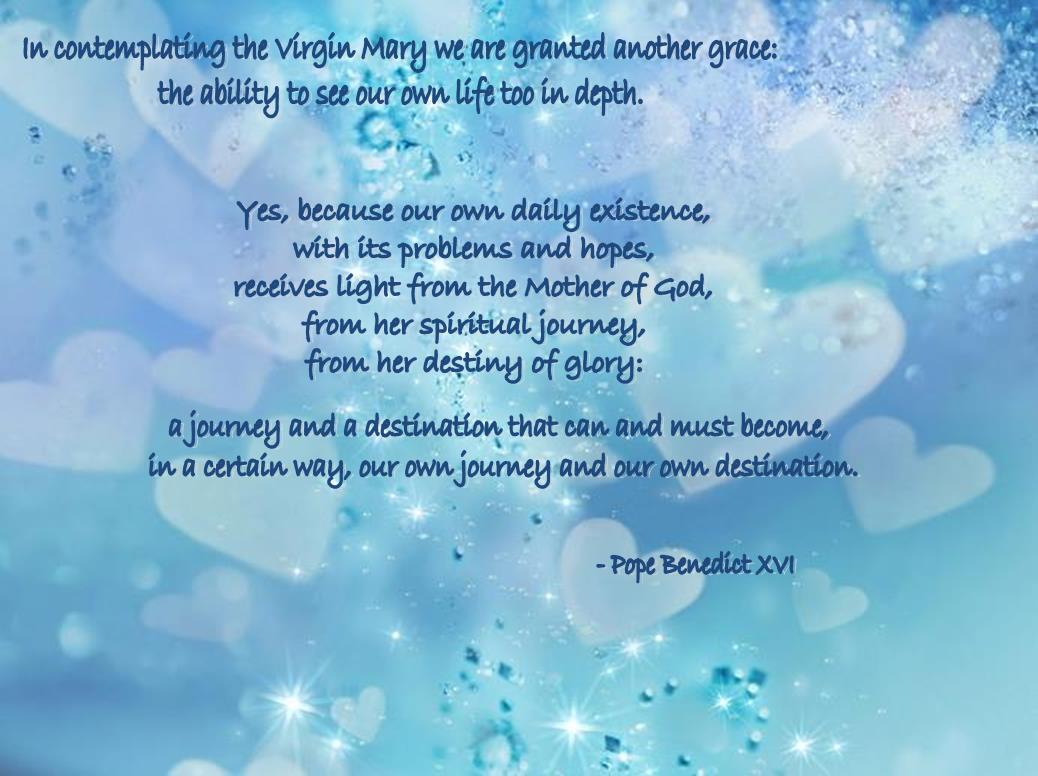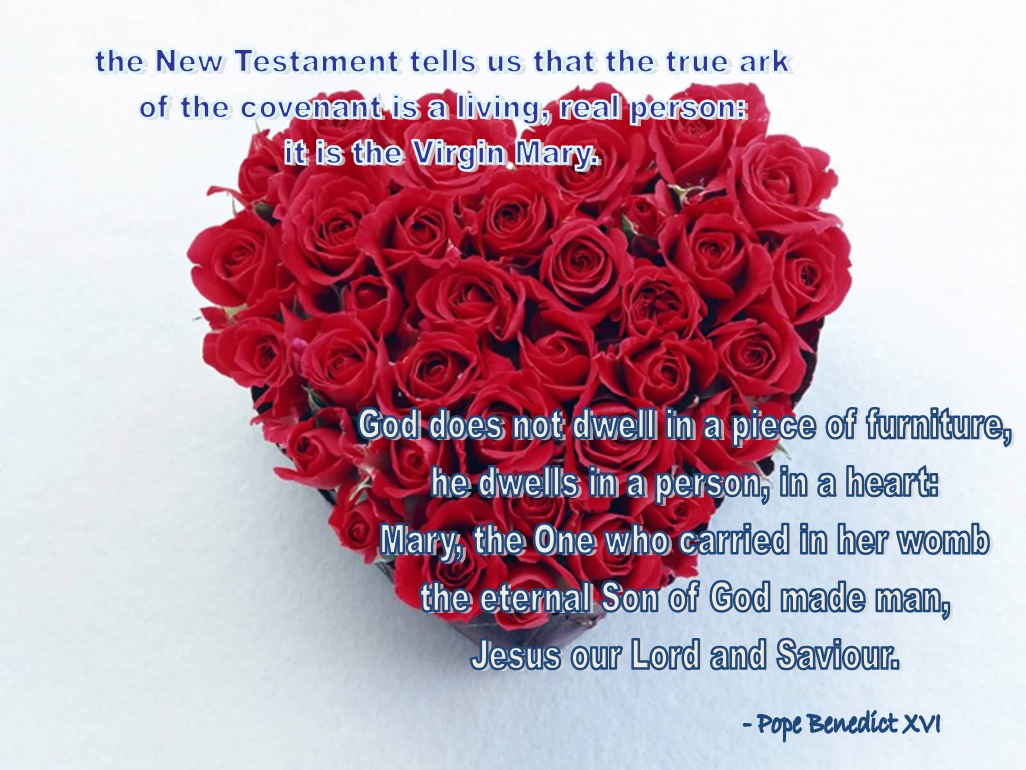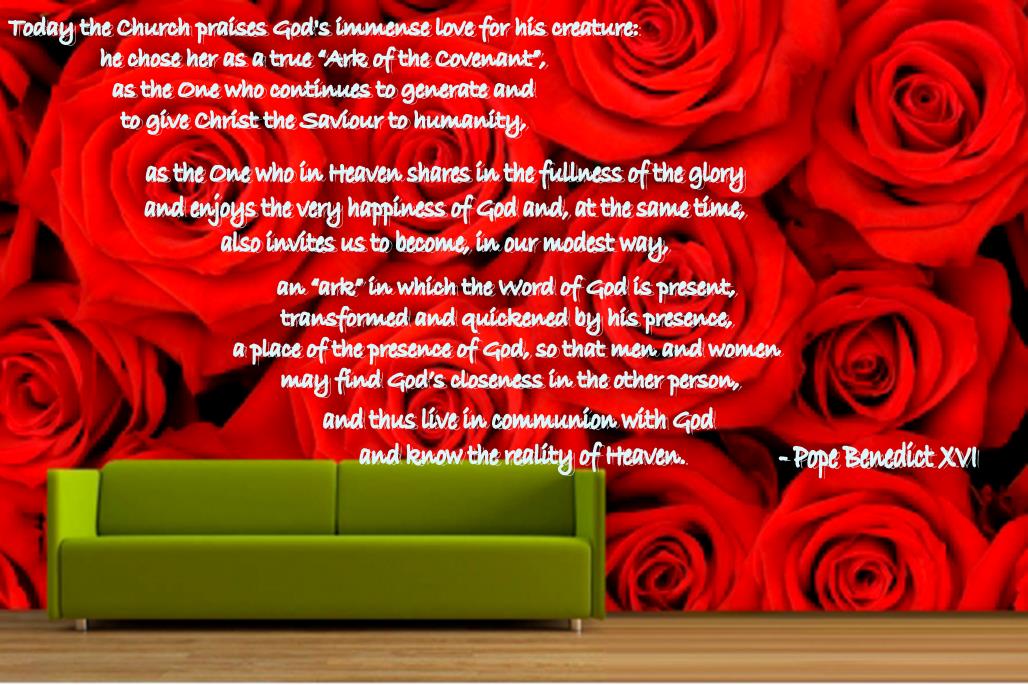|
18 August & 10 September 2012
The Homily of Pope Benedict XVI on the Solemnity of the Assumption of the Blessed Virgin Mary, Monday, 15 August 2011, given at St Thomas of Villanova Parish, Castel Gandolfo
Dear Brothers and Sisters,
We are gathered here, once again, to celebrate one of the oldest and best loved of the feasts dedicated to Mary Most Holy: the feast of her Assumption into the glory of Heaven in body and soul, in other words in the whole of her human existence, in the integrity of her person. Thus we have been given the grace of renewing our love for Mary, of admiring her and of praising her for the “great things” which the Almighty worked through her and brought about in her.
In contemplating the Virgin Mary we are granted another grace: the ability to see our own life too in depth. Yes, because our own daily existence, with its problems and hopes, receives light from the Mother of God, from her spiritual journey, from her destiny of glory: a journey and a destination that can and must become, in a certain way, our own journey and our own destination. |

|
Let us allow ourselves to be guided by the passages of Sacred Scripture the liturgy proposes to us today. I would like to reflect in particular on an image we find in the First Reading from the Book of Revelation, which is in fact echoed by Luke’s Gospel: the ark.
In the First Reading we heard: “God’s temple in heaven was opened, and the Ark of his Covenant was seen within his temple” (Rev 11:19). What is the meaning of the ark? What appears?
For the Old Testament, it is the symbol of God’s presence in the midst of his people. However, the symbol has given way to reality. Thus the New Testament tells us that the true ark of the covenant is a living, real person: it is the Virgin Mary. God does not dwell in a piece of furniture, he dwells in a person, in a heart: Mary, the One who carried in her womb the eternal Son of God made man, Jesus our Lord and Saviour.
In the ark — as we know — the two Tables of the Mosaic Law were kept. The Law expressed God’s wish to preserve the Covenant with his People, pointing out the conditions for being faithful to the pact with God in order to conform to God’s will and thereby also to our own profound truth.
Mary is the Ark of the Covenant because she welcomed Jesus within her; she welcomed within her the living Word, the whole content of God's will, of God’s truth; she welcomed within her the One who is the new and eternal Covenant, which culminated in the offering of his Body and his Blood: a body and blood received through Mary.
Therefore Christian piety rightly turns to Our Lady in the litanies in her honour, invoking her as Foederis Arca, that is, “the Ark of the Covenant”, the Ark of God’s presence, the Ark of the Covenant of love which God desired to establish with the whole of humanity, in Christ, once and for all.
The passage from the Book of Revelation also indicates another important aspect of Mary’s reality. As the living Ark of the Covenant, she has an extraordinary destiny of glory because she is so closely united to the Son whom she welcomed in faith and generated in the flesh, as to share fully in his glory in Heaven. This is what the words we have heard suggest: “A great portent appeared in heaven, a woman clothed with the sun, with the moon under her feet, and on her head a crown of twelve stars; she was with child.... She brought forth a male child, one who is to rule all the nations” (12:1-2; 5).
The greatness of Mary, Mother of God, full of grace, fully docile to the action of the Holy Spirit, already lives in God’s Heaven with her whole being, body and soul. St John Damascene, referring to this mystery in a famous homily, said: “Today the holy Virgin of Virgins is presented in the heavenly temple.... Today the sacred and living Ark of the living God [the Ark], who conceived her Creator himself, takes up her abode in the temple of God, not made by human hands” (Homily II on the Dormition, 2, PG 96, 723); and he continues: “It was meet that she, who had who had sheltered the divine Logos in her own womb, should inhabit the tabernacles of her Son.... The place of the Bride whom the Father had espoused, was in the nuptial chambers of Heaven” (ibid., 14 PG 96, 742). |
|
Today the Church praises God's immense love for his creature: he chose her as a true “Ark of the Covenant”, as the One who continues to generate and to give Christ the Saviour to humanity, as the One who in Heaven shares in the fullness of the glory and enjoys the very happiness of God and, at the same time, also invites us to become, in our modest way, an “ark” in which the Word of God is present, transformed and quickened by his presence, a place of the presence of God, so that men and women may find God’s closeness in the other person, and thus live in communion with God and know the reality of Heaven.
Luke’s Gospel which we have just heard (cf. Luke 1:39-56) shows us this living Ark — which is Mary — on the move: after leaving her home in Nazareth, Mary set out for the hill country, making haste to reach a city of Judah and go to the home of Zechariah and Elizabeth. It seems to me important to emphasize the expression “with haste”: God’s things deserve haste, indeed, the only things in the world that deserve haste are precisely those of God, which are truly urgent for our life.
So Mary entered the house of Zechariah and Elizabeth but she did not enter it alone. She entered carrying in her womb the Son, who was God himself, made man. In that house she and her help were of course expected, but the Evangelist leads us to understand that this expectation pointed to another, deeper expectation. Zechariah, Elizabeth and the little John the Baptist are in fact the symbol of all the just of Israel, whose hearts, full of hope, awaited the coming of the saving Messiah.
And it was the Holy Spirit who opened Elizabeth’s eyes and caused her to recognize Mary as the true Ark of the Covenant, the Mother of God, who was coming to visit her. Thus her elderly kinswoman welcomed her exclaiming with “a loud cry”: “Blessed are you among women, and blessed is the fruit of your womb! And why is this granted me, that the mother of my Lord should come to me?” (Luke 1:42-43).
And it was the Holy Spirit himself who, before her, the One who was carrying God made man, opened the heart of John the Baptist in Elizabeth’s womb. Elizabeth exclaimed: “For behold, when the voice of your greeting came to my ears, the babe in my womb leaped for joy” (v. 44).
Here the Evangelist Luke uses the term “skirtan”, that is “to leap”, the same term we find in one of the ancient Greek translations of the Old Testament to describe the dancing of King David in front of the ark of the Lord which had been brought into the city at last (2 Samuel 6:16).
In his mother’s womb John the Baptist danced like David before the Ark of the Covenant; like David he recognized: Mary was the new Ark of the Covenant, before which the heart exults with joy, the Mother of God present in the world who does not keep this divine presence to herself but offers it, sharing the grace of God. Thus, — the prayer says — Mary really is the “causa nostrae laetitae”, the “Ark” in whom the Saviour is truly present among us.
Dear brothers and sisters, we are speaking of Mary, but in a certain sense we are also speaking of ourselves, of each one of us: we too are recipients of that immense love which God reserved — of course, in an absolutely unique and unrepeatable way — for Mary. On this Solemnity of the Assumption let us look to Mary: She opens us to hope, to a future full of joy and teaches us the way to achieve it: welcoming in faith: by welcoming her Son with faith; by never losing the friendship with him but letting ourselves be illuminated and guided by his word; by following him every day, even in moments when we feel that our crosses are growing heavy.
Mary, Ark of the Covenant which is in the sanctuary of Heaven, show us with luminous clarity that we are on our way towards our true Home, the communion of joy and peace with God. Amen!
Acknowledgment: We thank the Vatican Publisher for allowing us to publish the Homilies of Blessed Pope John Paul II & Pope Benedict XVI so that they could be accessed by more people all over the world.
18 August & 10 September 2012 |

